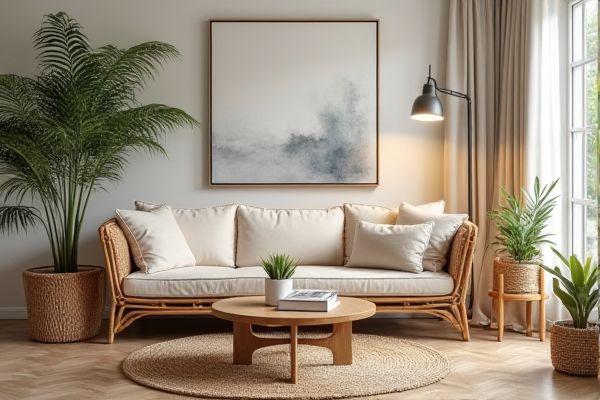
Synthetic rattan offers greater durability and weather resistance compared to natural rattan, making it ideal for outdoor furniture, while natural rattan provides a more authentic, eco-friendly look with a unique texture. Explore this article to discover which option best suits Your lifestyle and design preferences.
Table of Comparison
| Feature | Synthetic Rattan | Natural Rattan |
|---|---|---|
| Material | Polyethylene, resin, or plastic | Rattan vine from tropical palms |
| Durability | Highly weather-resistant, UV-proof, long-lasting | Prone to cracking, fading, and decay outdoors |
| Maintenance | Low; easy to clean with soap and water | High; requires regular treatment and protection |
| Appearance | Uniform, available in various colors | Natural, warm texture with unique grain patterns |
| Environmental Impact | Non-biodegradable, synthetic production | Biodegradable, eco-friendly renewable resource |
| Cost | Moderate to high depending on quality | Generally lower but varies by source and craftsmanship |
| Usage | Ideal for outdoor furniture, resistant to elements | Best for indoor use or sheltered outdoor areas |
Introduction to Rattan: Synthetic vs. Natural
Synthetic rattan, made from polyethylene or resin, offers superior durability, weather resistance, and low maintenance compared to natural rattan, which is derived from the flexible stems of the Calamus palm. Natural rattan provides a classic, authentic aesthetic with a lightweight, eco-friendly composition but is prone to moisture damage and requires regular upkeep. Choosing synthetic or natural rattan depends on factors like desired longevity, environmental exposure, and maintenance preferences.
Material Composition and Manufacturing
Synthetic rattan is crafted from high-density polyethylene (HDPE) or other weather-resistant plastics, engineered through extrusion and weaving processes to mimic the look of natural fibers while enhancing durability and UV resistance. Natural rattan originates from the flexible stems of tropical climbing palms, harvested and hand-woven, resulting in a biodegradable and organic material with unique textures but lower resilience to moisture and sunlight. Your choice depends on the balance between synthetic rattan's long-lasting, maintenance-free properties and the authentic, eco-friendly appeal of natural rattan.
Appearance and Aesthetic Differences
Synthetic rattan boasts a uniform texture and consistent color, providing a sleek, modern appearance that resists fading and wear. Natural rattan features unique, organic patterns with rich, earthy tones and subtle variations, giving it a warm, rustic charm that ages gracefully over time. The choice between synthetic and natural rattan hinges on desired aesthetic durability and the mood of the environment, blending contemporary precision or natural authenticity.
Durability and Lifespan Comparison
Synthetic rattan outperforms natural rattan in durability and lifespan due to its resistance to weather elements, UV rays, and moisture, making it ideal for outdoor furniture exposed to varying conditions. Natural rattan, while offering a classic aesthetic and biodegradability, is prone to cracking, fading, and deterioration when exposed to humidity or direct sunlight over time. Your choice between the two should consider the intended use environment, as synthetic rattan ensures longer-lasting performance with minimal maintenance compared to natural rattan's susceptibility to wear and seasonal damage.
Resistance to Weather and Environmental Factors
Synthetic rattan offers superior resistance to weather and environmental factors compared to natural rattan, as it is made from durable polyethylene or resin materials that withstand UV rays, rain, and humidity without deteriorating. Natural rattan, being an organic material, is prone to mold, fading, and cracking when exposed to prolonged moisture and sunlight. For your outdoor furniture needs, synthetic rattan ensures longer-lasting performance and minimal maintenance in varying weather conditions.
Maintenance and Cleaning Requirements
Synthetic rattan offers low-maintenance benefits, requiring only simple cleaning with mild soap and water to prevent dirt buildup and mold growth. Natural rattan demands more care, including regular dusting and occasional treatment with oil or varnish to protect it from moisture damage and cracking. Your choice depends on how much effort you want to invest in upkeep, with synthetic rattan being ideal for easy, hassle-free maintenance.
Eco-Friendliness and Sustainability
Synthetic rattan, made from polyethylene or other plastics, offers durability and low maintenance but poses environmental challenges due to its non-biodegradable nature and reliance on fossil fuels. Natural rattan, harvested from rattan palm species, is biodegradable and renewable, supporting sustainable forestry practices and carbon sequestration when sourced responsibly. Choosing natural rattan promotes eco-friendliness by reducing plastic waste and encouraging habitat conservation, while synthetic alternatives demand more careful waste management and recycling efforts.
Cost Effectiveness and Pricing
Synthetic rattan offers greater cost effectiveness compared to natural rattan due to its lower production and maintenance expenses, making it a budget-friendly option for outdoor furniture. In pricing, synthetic rattan tends to be more affordable upfront and provides long-term savings by resisting weather damage and reducing replacement costs. Your investment in synthetic rattan ensures durable, low-maintenance furniture without compromising style or affordability.
Best Uses: Indoor vs. Outdoor Applications
Synthetic rattan excels in outdoor applications due to its weather-resistant properties, UV protection, and durability against moisture, making it ideal for patios, gardens, and poolside furniture. Natural rattan, favored for indoor use, offers a warm, organic aesthetic but requires protection from humidity and direct sunlight to maintain its integrity. Choosing between the two depends on whether your focus is on long-lasting outdoor resilience or natural elegance within indoor settings.
Choosing the Right Rattan for Your Needs
Synthetic rattan offers superior durability and weather resistance, making it ideal for outdoor furniture and areas exposed to moisture or sunlight. Natural rattan provides a classic, organic aesthetic and is valued for its lightweight and flexibility, but requires more maintenance to prevent wear and damage. Selecting the right rattan depends on your environment, desired appearance, and maintenance capacity.
 homyna.com
homyna.com